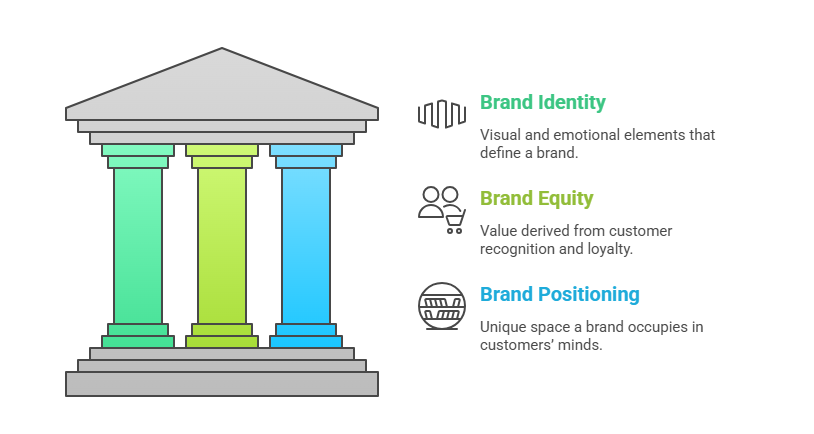Brand management is the art of shaping a brand identity that captures customer loyalty and fuels business growth. For students diving into marketing, mastering marketing strategies for brand management is essential to ace exams, shine in projects, and land roles in advertising or strategy. This guide explores how to build and sustain a powerful brand identity, offering practical tips, real-world applications, and insights to help you excel academically and kickstart your career. Whether you’re creating a mock campaign or preparing for a viva, these marketing strategies will set you up for success.
Understanding Brand Management and Its Components
Brand management is about strategically crafting how customers perceive a business, turning a product or service into a trusted name. It’s not just about logos or slogans—it’s about creating an emotional connection that makes customers choose one brand over another, like preferring a familiar street vendor’s snacks over a new one. For business students, understanding brand management is crucial for marketing coursework, viva questions, and internships. As noted by Business Standard, strong brands can significantly boost customer loyalty, making this a must-learn skill.
Key Components of Brand Management

- Brand Identity: Visual and emotional elements like logos, colors, and values that define a brand.
- Brand Equity: The value from customer recognition and loyalty.
- Brand Positioning: The unique space a brand occupies in customers’ minds compared to competitors.
Each component plays a vital role. Take brand identity—it’s the face of the brand, combining visuals like a logo with values like trust or innovation. For example, a small retail business in an Indian city might launch a clothing line with a sleek logo and a tagline like “Style for Everyone,” emphasizing affordability. This creates a recognizable image that customers associate with quality. Brand equity builds on this, as consistent quality turns first-time buyers into loyal customers. Imagine a local food stall gaining a reputation for tasty, reliable snacks—customers return, and the brand’s value grows. Brand positioning ensures the brand stands out. A startup selling tech gadgets might position itself as “affordable innovation,” appealing to young professionals in India’s competitive market. For students, these concepts are key for exam questions like “Explain brand equity” or projects designing mock brands, preparing you for real-world roles in marketing.
Exam Tip: Use simple examples, like a local shop, to explain components in short-answer questions.
Strategies for Building Brand Identity
Creating a compelling brand identity is the foundation of brand management, requiring marketing strategies that resonate with customers. Here are the core strategies:
- Define Core Values and Mission: Establish what the brand stands for, like quality or sustainability.
- Create Consistent Visuals: Use unified logos, colors, and packaging for recognition.
- Leverage Storytelling: Share stories to connect emotionally with customers.
- Target the Right Audience: Focus on specific customer segments for effective messaging.
Defining core values gives a brand its soul. For instance, a small fashion business in India might center its brand identity on sustainability, using eco-friendly materials and a mission statement like “Fashion with a Conscience.” This resonates with environmentally aware customers, building trust and loyalty. Students can practice this in college projects by drafting a mission statement for a hypothetical brand, which also helps with exam questions on brand purpose. A clear mission aligns all branding efforts, making the brand authentic and appealing.
Consistency in visuals, like logos and color schemes, ensures customers recognize the brand instantly. Picture a cozy café in a bustling Indian market using warm, earthy tones across its signage, menus, and Instagram posts. This unified look creates a welcoming vibe that customers remember. Students can apply this by using tools like Canva to design mock logos or posters for assignments, learning how visuals shape perceptions. Consistent visuals are critical, as even small mismatches can confuse customers and weaken the brand.
Storytelling brings a brand to life by forging emotional connections. A startup selling handmade crafts might share the story of local artisans behind its products, inspiring customers to support the brand. This narrative makes the brand relatable, turning buyers into advocates. Students can practice storytelling in presentations by creating a brand narrative, which prepares them for viva questions on customer engagement. A good story can make a brand unforgettable, boosting its brand identity.
Targeting the right audience ensures marketing strategies hit the mark. A tech business might focus on young professionals in India, using social media ads to highlight affordable gadgets. This precision maximizes impact and efficiency. Students can apply this in projects by conducting audience surveys, perhaps for a mock campaign, which also helps with exam questions on segmentation. Knowing your audience is key to building a brand identity that resonates.
Table: Strategies for Building Brand Identity
| Strategy | Key Benefit | Challenge | Action Tip |
|---|---|---|---|
| Core Values | Builds customer trust | Defining authentic values | Draft a mission statement |
| Consistent Visuals | Enhances recognition | Design expertise | Use Canva for mock designs |
| Storytelling | Boosts emotional connection | Crafting compelling stories | Share a founder story |
| Target Audience | Improves campaign efficiency | Accurate segmentation | Conduct audience surveys |
Action Tip: Practice one strategy per project to master brand management.
Sustaining Brand Identity Over Time
Once a brand identity is built, sustaining it ensures long-term success. This requires ongoing effort to keep the brand relevant and trusted in a dynamic market. A key approach is monitoring brand perception through customer feedback. For example, a retail business in India might use Instagram polls to ask customers about product quality or service, ensuring the brand aligns with their expectations. This feedback loop helps address issues early, maintaining trust. Students can apply this in projects by analyzing feedback for a mock brand, preparing for exam questions on brand monitoring. Staying attuned to customer opinions keeps a brand vibrant and responsive.
Adapting to market trends is crucial to avoid becoming outdated. Consumer preferences, especially in India’s fast-evolving markets, shift with trends like digital shopping or sustainability. A food business might introduce online ordering to meet the demand for convenience, keeping its brand identity fresh. Students can explore this in marketing reports by studying trends like social media campaigns, which also helps with viva discussions on market responsiveness. Adapting to trends ensures a brand remains competitive and relevant.
- Consistent Engagement: Regular communication via social media or newsletters reinforces brand identity. A service business might post weekly LinkedIn updates about its offerings, keeping customers engaged.
- Reputation Protection: Addressing negative feedback transparently prevents damage. A startup facing complaints about delays on Twitter can respond promptly, offering solutions to maintain trust.
These efforts build loyalty and keep the brand top-of-mind. Students can practice engagement by creating a mock campaign schedule or role-playing crisis management in group projects, preparing for case-based exam questions. Sustaining a brand identity requires vigilance and adaptability, ensuring long-term customer connection.
Exam Tip: Explain sustaining strategies with examples like social media engagement for descriptive answers.
Benefits and Business Implications
A strong brand identity through effective brand management delivers significant benefits that impact both academics and careers. A well-crafted brand fosters customer loyalty, encouraging repeat purchases and referrals. For instance, a retail business in India that delivers consistent quality builds a loyal customer base, driving steady revenue. This loyalty is a key economic benefit, as loyal customers are less sensitive to price changes, ensuring stability. Students can explore this in projects by analyzing how loyalty impacts sales, a common exam topic that showcases practical understanding.
Another major benefit is competitive advantage. In India’s crowded markets, a unique brand identity sets a business apart. A tech startup positioning itself as “innovative yet affordable” captures market share by appealing to young professionals. This differentiation is critical for success and often tested in viva questions on market positioning. For students, mastering this concept can impress internship recruiters looking for strategic thinkers.
- Career Opportunities: Brand management skills are in demand for roles in advertising and marketing. A student who creates a compelling branding project for a college fest might land a branding internship.
- Revenue Growth: Strong brands command premium pricing. A fashion business with a trusted brand identity can charge more, boosting profitability.
These implications enhance employability and economic outcomes. Students can highlight branding projects on resumes or LinkedIn, showcasing skills to potential employers. Understanding these benefits prepares you for exam questions like “How does branding drive business success?” and real-world marketing roles.
Table: Business Implications of Brand Management
| Implication | Economic Benefit | Practical Challenge | Action Tip |
|---|---|---|---|
| Customer Loyalty | Increases revenue | Maintaining consistency | Focus on quality |
| Competitive Advantage | Captures market share | Differentiation in competition | Use unique positioning |
| Career Opportunities | Enhances employability | Limited experience | Highlight projects in resume |
| Revenue Growth | Boosts profitability | High branding costs | Leverage cost-effective tools |
Action Tip: Build a portfolio with branding projects for internship applications.
Challenges in Brand Management
- Intense Competition: Standing out in saturated markets like India’s retail sector is tough. A startup might struggle against established brands. Solution: Use unique storytelling or target niche audiences.
- Consistency Issues: Inconsistent messaging confuses customers. A café with mismatched visuals across platforms weakens its brand identity. Solution: Create a brand guideline document.
- Budget Constraints: Branding campaigns can be costly. A small business might lack funds for ads. Solution: Use free tools like Canva or social media.
- Changing Preferences: Evolving trends challenge relevance. A fashion brand risks losing appeal without trendy designs. Solution: Monitor trends via Forbes India.
These challenges require proactive strategies. Students can practice solutions in assignments, like drafting guidelines or analyzing trends, preparing for exam questions on branding obstacles.
Exam Tip: Discuss one challenge and its solution in detail for long-answer questions.
Exam and Career Prep Tips for Brand Management
- Master Concepts: Learn brand equity and positioning for theory questions.
- Apply in Projects: Create mock campaigns, like a branding plan for a college event, for viva.
- Research Careers: Explore advertising roles on LinkedIn.
- Use Resources: Check HubSpot’s Marketing Blog for trends.
- Build a Portfolio: Showcase branding projects on LinkedIn or resumes.
These tips boost academic performance and career readiness. For example, designing a sample logo for a class presentation can impress professors and prepare you for internship interviews.
Action Tip: Create a mock campaign for a viva to demonstrate practical skills.
Customer Relationship Management (CRM): A Comprehensive Guide for Business Management Students
Conclusion
Brand management is the key to building and sustaining a brand identity that drives loyalty, competitive advantage, and growth. By mastering marketing strategies like storytelling and audience targeting, you can excel in exams and prepare for a thriving marketing career. Start applying these strategies today, and explore resources like Economic Times to stay ahead in creating brands that resonate and endure.
👨💼 Author: BBAProject Editorial Team
✍️ The BBAProject Editorial Team comprises business graduates and educators dedicated to creating practical, syllabus-based learning resources for BBA students.
⚠️ Please Note: Articles published on BBAProject.in are well-researched and regularly updated. However, students are advised to verify data, statistics, or references before using them for academic submissions.

